Scientists crack the ‘Brazil nut puzzle’
It’s not often that you say this, but this scientific mystery begins with a bag of nuts. It’s long been observed that if you buy a bag of mixed nuts, the large Brazil nuts always rise to the top. The question of exactly why this is the case is one that, for a surprisingly long time, has proven elusive to scientists, but new research from a team at the University of Manchester has finally cracked these nuts. It’s a fun curio, but the technique used here may have really useful real-world applications.
Although the problem is most commonly associated with nuts, you can also see it in cereal packets – it’s famously been understood that a toy in the box is likelier to be at the top if you shake it, and it’s exactly the same principle. In any granular material, larger particles tend to rise to the surface. The difficulty, however, is monitoring what is actually happening to the particles within a pile, and that’s where this new research comes in.
The significance of this study is far greater than simple nuts
The researchers used an advanced imaging technique called time-lapse X-ray computed tomography to track a collection of Brazil nuts underneath a selection of peanuts. They tussled the mixture repeatedly, and observed what happened – after 45 tussling cycles, a few Brazil nuts were nearing the top of the mixture and, by the 135th cycle, their big heads had breached the surface. This was not the case with all the nuts – some of the Brazils appeared trapped on the bottom and failed to rise upwards – but the vast majority of the nuts conformed to expectations. You can see a video of the experiment and the movements of the nuts here:
Orientation, it transpired, was a key factor in this movement. According to Dr Parmesh Gajjar, lead author of the study: “Critically, the orientation of the Brazil nut is key to its upward movement. We have found that the Brazil nuts initially start horizontal but do not start to rise until they have first rotated sufficiently towards the vertical axis. Upon reaching the surface, they then return to a flat orientation.” Once the Brazil nuts were in the vertical position, it was easier for peanuts to travel down past them, essentially forcing the Brazil nuts up in the process. By the time bags of nuts make it to the supermarket, they’ve already been shaken up enough that the Brazil nuts have climbed.
The significance of this study is far greater than simple nuts. As Dr Gajjar notes: “This ability to track the motion in 3D will pave the way for new experimental studies of segregating mixtures and will open the door to even more realistic simulations and powerful predictive models. This will allow us to better design industrial equipment to minimise size segregation thus leading to more uniform mixtures. This is critical to many industries, for instance ensuring an even distribution of active ingredients in medicinal tablets, but also in food processing, mining and construction.”
Uneven mixing can critically degrade product quality in many industries, so better understanding this process has significant financial implications. What initially appeared to be a bit of fun about a bag of nuts could alter how we make medicines and process food, so the team will look to build on their research and also find ways to resolve the problem. The applications of this work are numerous – bear that in mind next time you have to dig past all the Brazil nuts.

Comments